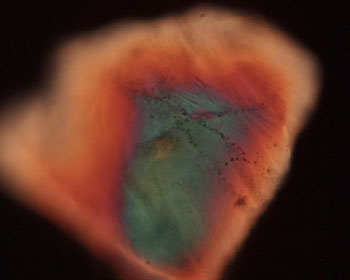|
GEULHEMMERBERG K/Pg BOUNDARY |
|
Map showing the position of the numbered images of the of the walls of the cave.
|
|
|
|
|
 |
|
|
Stratigraphic column of the KPg boundary transition in the Geulhemmerberg caves where the detailed sampling was taken |
Pseudo shocked quartz grain from burrow underneath channels (IG3). Maartje Hamers discounted (pdf) them as shocked in her PhD thesis! (full thesis)
|
|
The K/Pg boundary (Fig.1) (enlargement) |
|
|
Geologie & Mijnbouw (pdf chapters) published a Special Issue (79-2,/3 1996) of the initial studies of the KPg boundary in the Geulhemmerberg caves: The Geulhemmerberg Cretaceous-Tertiary boundary section in the Maastrichtian type area. Sections across the Cretaceous/Tertiary (KPg) boundary in a shallow marine setting above wave-base, without a significant hiatus at the boundary are almost non-existent. A few continuous sections are known such as : Brazos River. Texas (US Gulf Coast; Mancini & Tew 1993), Stevns Klint (Denmark; Schmitz et al. 1992) and possibly Poty (NE Brazil; Albertao et al. 1994). However, these sections are clearly below wave base. Carbonate platform sequences -or clastic sequences above wave base- are almost invariably incomplete, with a hiatus of variable magnitude at the KPg boundary. Therefore, it came as a pleasant surprise that decimetre-thick clay layers (Fig.1) were discovered near the boundary in man-made caves in the Geulhemmerberg , 7 km ENE of Maastricht in the south of the Netherlands (Fig. 2; Fig3). The discovery was made by Jaques Severijns and Rudi Dortangs of the Nederlandse Geologische Vereniging and later reported to Werner M. Felder. Felder mentioned the clays to A.J.T. Romein, H. Brinkhuis and J. Jagt during a fieldtrip in 1990 to the Curfs quarry. Romein, Brinkhuis and Jagt were sampling the Curfs quarry in the course of project 750.610.01 of the Netherlands Geoscience Foundation (GOA) to investigate dinoflagellate distributions across the KPg boundary and to test the presence of alleged Danian nannofossil index markers in 'Upper Maastrichtian' strata of the Meerssen chalk Member of the Maastricht Formation. Preliminary analyses of the first samples of the clay revealed basal Paleocene dinoflagellate and nannofossil assemblages. After new localities were found in the caves with up to seven successive claylayers, the 'Deep Dark Hole' project was started (panorama, Fig5). Scientists from different disciplines were invited to investigate splits of the same sample set that was taken in 1992 at one of the best accessible locations, in the centre of one of the deeper depressions (fig 6) in the paleorelief formed by the Berg & Terblijt Horizon (see below), the so-called "main sampling site" (Fig. 4), (see Fig 5: sample series IG 1 - 22 and G 1 - 7). The main results are presented in this issue. The caves were made in the interior of the Geulhemmerberg in the 18th and 19th century as result of the quarrying for building-stones. Because it is free of chert, the quarry-men followed a specific 3m-thick layer of the Meerssen member, unit IVf - 6 of Felder (1975a,b), just below a hardground, which is visible in the roof of the caves. At some places, in particular where relatively thick clay layers are present, the roof has collapsed exposing the clay layer sequence. |
|
(Complete introduction to the Geulhemmerberg issue:( Geol&Mijnb. 79-2) pdf)) |
|